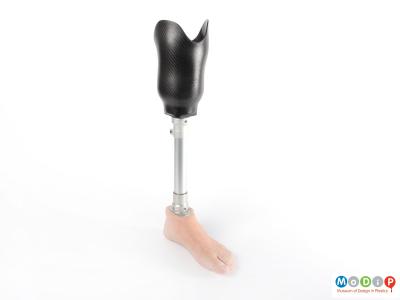When a part of the body is absent from birth or lost due to injury or disease, it is sometimes possible to replace it. Transplants use a donor’s or the patient’s own tissues for reconstructive surgery. However, if the missing parts are too large or too complex, one alternative is to use an artificial substitute.
Different types of prosthetic limbs are designed to achieve different objectives. For example, a cosmetic prosthetic limb, called a cosmesis, is designed predominantly for appearance; to look as realistic as possible. Other prosthetic limbs are designed with usability and function as their main purpose. Using plastics and modern composite materials within the design enables prosthetics to be light, strong, comfortable and durable.
The transtibial (below knee) prosthesis (1) was custom made for MoDiP by Dorset Orthopaedic, a local, independent provider of prosthetics. This example has a carbon fibre socket, a titanium shin tube and a silicone foot. The lifelike foot is handsculpted, built up in layers over a dense foam shell, with each layer of silicone pigmented to match the patient’s own skin tone. For extra detail and individuality, nails, veins, freckles, hair follicles, liver spots and tattoos can all be added.
The Ossur Flex-Run running blade (2) is made from carbon fibre with a Nike sole attachment for grip. Intended for high impact activity such as jogging, running and triathlons, it was developed with Sarah Reinertsen, an American paratriathlete and former Paralympic track athlete. After studying her performance, the Ossur engineers extended the blade at the toe for more powerful push-offs and faster acceleration, and adjusted the c-shaped curve to provide greater forward propulsion. Nike produced the replaceable, multi-layered sole for traction, using recycled materials from the brand’s ‘reuse-a-shoe’ programme. Previously blade users had had to resort to cutting off the soles from conventional running shoes to glue onto their prosthesis to achieve the same result.


